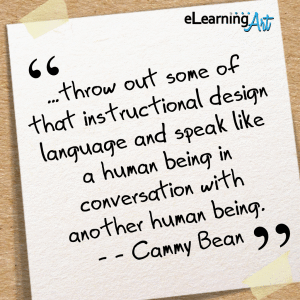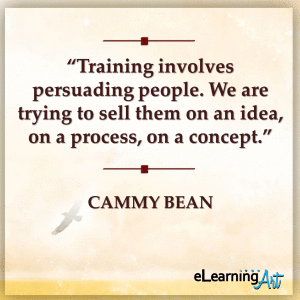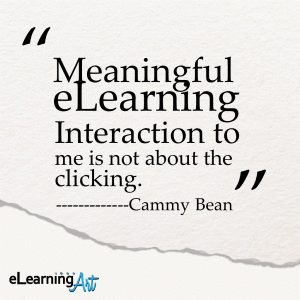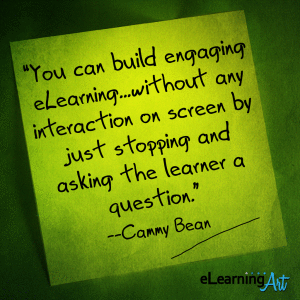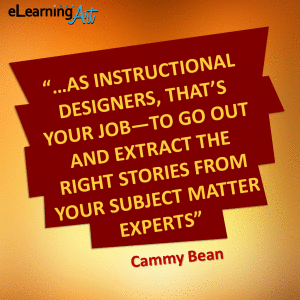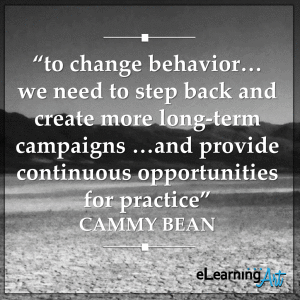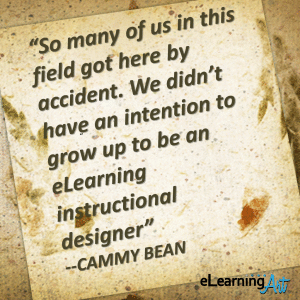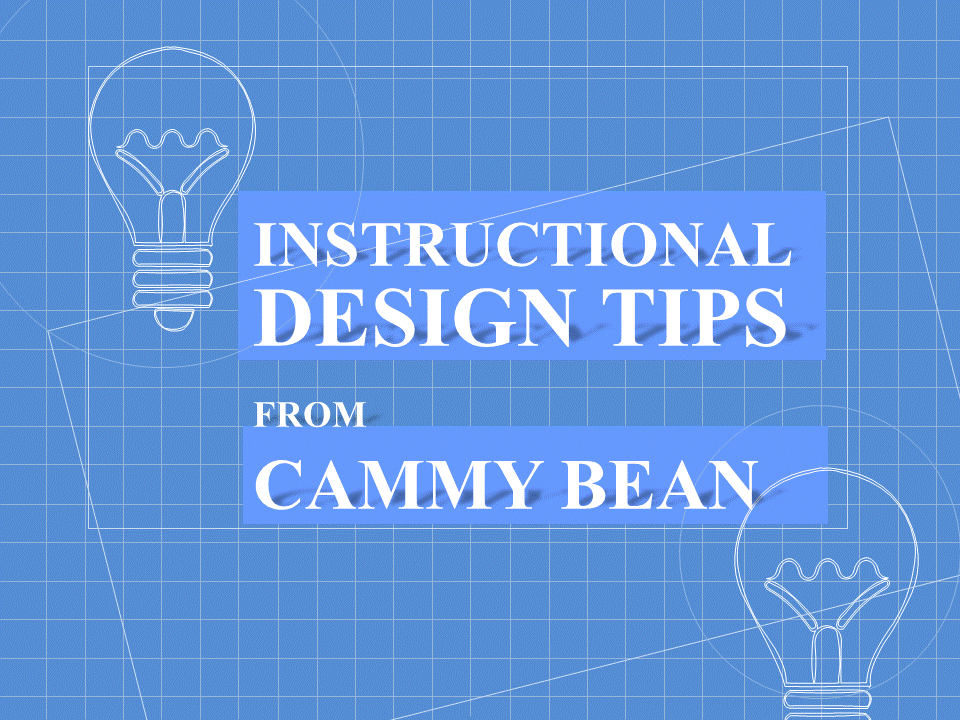
I recently had the opportunity to interview Cammy Bean, a frequent speaker and popular eLearning blogger. She shared many practical instructional design tips that you can use to improve the training you build.
And now, on with interview!
How do strangers react when you tell them you’re an instructional designer?
I think a lot of instructional designers struggle with that. Once I explained my job to someone and he was horrified. He started hissing at me and he said, “You’re the CBT lady.” And he went on to describe all these horrible things that eLearning at a lot of corporate institutions looks like and what it represents. It’s locked down courses. It’s really boring. It’s text boxes on screen. It’s getting one question wrong on a test and having to start the whole thing over.
And it sounded like a really painful experience.
Are all instructional designers destined to be the “CBT Lady”?
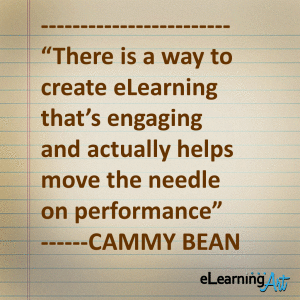
Why do you think there’s so much bad training?
The CBT lady has created these really boring pieces of “eLearning” and employees don’t value it. They don’t want to suffer through it. And senior managers and senior stakeholders hate it and think it’s really boring. So they don’t want to pay for it. So it’s becoming this kind of downward spiral because there’s no perceived value in it.
So how do we change that as professionals? How do we go back in and show people that there is a better way? You may have to invest a little bit more in it because thoughtful design does take time and some resources.
What’s one way people can build better eLearning today?
Become a better writer by directing your writing at the learner. eLearning is about human beings sitting down at computers, going through online experiences. Far too often that human element gets forgotten.
So throw out some of that instructional design language and speak like a human being in conversation with another human being. Talk as if you’re sitting down at a table having coffee with someone, having a conversation about this content. And that’s something that you can start doing right now.
What can we learn from sales people and marketers?
Training involves persuading people. We are trying to sell them on an idea, on a process, on a concept. And we want to sell them on this idea that they need to change their own behavior.
So the challenge is to create compelling messages that really tap into that and answer the question: ‘What’s in it for me? Why do I care about this?’ But doing it in a way that really does entice and attract is huge. The CBT lady does not know how to do that well. She doesn’t know a thing about marketing.
How do people get eLearning interaction wrong?
Meaningful interaction to me is not about the clicking. It’s what I call clicky-clicky bling-bling. It’s just all shiny and sparkly and ooh and ah, which actually can distract from the learning experience. So if you have too much bling, all that the learner’s going to remember is how shiny it was and they’re not going to remember the content that really matters.
So you want to steer away from that jeopardy board or your miniature golf course quiz that has no contextual relevance to the learner’s life; it’s what Sebastian Deterding calls a “disconnected challenge.” So if you give people this challenge that they have to solve this jeopardy board, what becomes more compelling is answering all the questions on the jeopardy board, not really figuring out to apply them back into your own world. I don’t want to just totally throw out these types of templates, but I think they get misused way too much.
On the other end, you want to avoid the “clicky-clicky blah-blah,” which is just boring. Boring like 8,000 clicks on a screen to uncover all the content–and it’s just dreadfully boring.
So what makes for good eLearning interaction?
Make sure that the learner is engaging with the content in a meaningful way. So it’s about cognitive interactivity. It’s using your brain to think about the content. And you can do that without any interaction on screen by just stopping and asking the learner a question: “What do you think about this? How are you going to apply this in your own world?”
You could ask them to write something down on a piece of paper. “Write down the name of one person that you can call after you’re done here to discuss this with.” If it’s a sales training course, maybe there’s two people you can share XY and Z with after today. Write down an action plan. Give them ways to interact with the content that’s relevant to their own life and that could be truly meaningful and not about the clicking on screen. So don’t assume that interaction has to be about clicking.
How do you like to incorporate stories into the training you build?
Stories are a way to make eLearning content much more relevant. It’s kind of like dress rehearsal. In Made to Stick, the authors Chip and Dan Heath say that the second best thing to actually doing the activity is to see a story unfold. They say that stories are a flight simulator for the brain. Just by reading along in a story, putting on that person’s shoes and experiencing life through their eyes for that moment–it can be almost like a practice exercise.
So how can you do that in a meaningful way that is relevant to the situation and has that context? That’s a challenge. But as instructional designers, that’s your job–to go out and extract the right stories from your subject matter experts and work with them to home in on the areas where people make mistakes in the real world–because that’s where we’re going to get the most bang for our buck. Focus on those three top mistakes and have your story highlight those mistakes. Give people the experience of making those mistakes through those stories.
We actually use eLearningArt character packs to tell stories of people. And it’s nice because you provide lots of different poses and you can tell that story and show a conversation in a meaningful way so that people get that sense of going along with it. Stories are a great way to give life to the content and provide that relevance.
Explain the difference between teaching a skill and changing behavior.
Changing behavior is something that we don’t see a lot of in eLearning really. We see a lot of teaching knowledge and skills or informing people about a new policy, putting out the word that there’s this new thing that you need to be aware of. But there’s less of that true behavior change. I think the reason for that is changing behavior takes time. And I would venture to say a lot of corporate training in general, they don’t invest that kind of time.
If you want to change habit at home or lose weight or stop smoking, that takes time and it takes repeated exposure to messaging and to reminders and those cues. So instead of thinking about creating a single learning event, we need to step back and create more long-term campaigns and think about ways to reinforce those methods and provide continuous opportunities for practice over an extended period of time so that ultimately we can change behavior.
What’s the biggest challenge most IDs face?
One of the biggest challenges for organizations is they feel like their culture is too stuffy and they’re not allowed to be more human in a way, if that makes any sense. So if you try to make the tone more conversational, there can often be resistance to that because people think, “well it’s not professional enough.”
So as an instructional designer your job is to educate your internal client on why this is a better way and why a more human approach is actually going to have more impact in the long run.
What advice do you have for the one-person training department?
There’s a huge percentage of instructional designers working within organizations who are a one-stop shop. Where you are the graphics person, the writer, the developer, the programmer, the learning expert, and more. The person in a one-man shop is wearing a lot of different hats all at once. And those are a lot of really different skillsets. And it’s really overwhelming. The person who can do those all really well is truly some kind of a superhero and is a rare, rare individual. I do not do all of those things!
It’s a big job and stakeholders don’t often understand that. So what you may end up with is eLearning is more like what the CBT lady can put out because she is trying to juggle so many things at once. And it’s as good as it’s going to be. And that is a real challenge. So how can you change that within your organization? If you can kind of share that motto, you can go talk to your boss and your…those higher up stakeholders and say, “You know what, this really is a lot of different skillsets. And if we want to do more quality programming here internally, we need to think about either working with external partners or hiring additional individuals within our organization who have skills and expertise to balance out my own.”
Before you go, tell us. How did you become an instructional designer?
So many of us in this field got here by accident. We didn’t have an intention to grow up to be an eLearning instructional designer when we were children. In fact, when I was a kid, there was no eLearning. It didn’t exist. It wasn’t a field. So why would I have even aspired to it? But through a series of fortunate happenstance and accidents and being in the right place at the right time and having skills and aptitudes in certain ways, I ended up with a job title of instructional designer.
How did you make the transition to an “intentional” instructional designer?
It was 2005 and people were blogging and there was a whole community of eLearning professionals out there trying to figure out how to use this thing called the Internet that was really exploding. And eLearning was becoming more mature. So there was this great community of people starting to connect. And I tapped into that, and I said, “You know what. I’m going to be doing this probably for the rest of my grown up life, and I should do it with passion and with great intention.”
I called it getting an informal degree in instructional design. So I started reading a lot of books and talking to a lot of people and writing my own blog. And that really was a jumpstart. And here I am today, very much through that process.
Get More from Cammy
If you liked this interview, check out Cammy’s book: The Accidental Instructional Designer.


